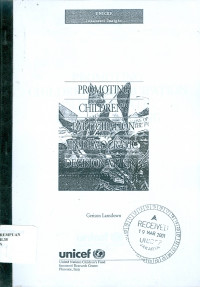
Text
Promoting children's participation indemocratic decision making
Since the adoption of the Convention on the Rights of the Child (CRC) ‘child participation’ has been the subject of an increasing flood of initiatives, ranging from research and publications to conferences and concrete projects. Over the past ten years, work has been developed from local to international level, in a wide range of contexts, involving children of all ages, in countries throughout the world and from every conceivable social and economic situation. National and local governments, UN Agencies, international and national NGOs, community groups and schools have started to explore what we mean by consultation, participation, partnership and empowerment. This is still, of course, very much an experimental phase. Different practices have been introduced, different definitions of participation are being explored, different levels of power shared. There are impassioned arguments about the appropriate degree of priority to be afforded to participation from both a practical and a human rights standpoint, and whether it is an end in itself, a means to the end of promoting and protecting human rights, or both. ‘Experimental’ means that, inevitably, sometimes the wrong course will be followed and that mistakes will be made. ‘Experimental’ also implies, however, a conscious and constant effort to analyse processes and outcomes, and to learn from any errors. Listening to children and considering seriously what they have to say can hardly be said to have been a frequent hallmark of inter-personal relationships or societal organization. The participatory thrust of the CRC demands considerable - sometimes profound - change in cultural attitudes towards children. Even adults who are utterly sympathetic to the principle of enabling children to express their views may often feel uncomfortable with the ways, means and implications of putting this into practice. Indeed, children themselves frequently experience similar feelings of unease. This publication has been produced in the context of this rapidly changing and turbulent environment. It makes the case for a commitment to respecting children’s rights to be heard and the need to consolidate and learn from existing practice. It draws on much of the already published research and thinking in the field and on a wide range of international initiatives. In so doing, it seeks to provide some practical guidance on the lessons learned to date in working with children as partners. It is anything but a definitive bible – rather a contribution to the development of tools for those who see children’s rights to be heard as a means of promoting and protecting their other rights.
Availability
| KP IV.6.00036 | KP.IV.6 LAN p | My Library | Available |
| KP IV.6.00036-01 | KP IV.6 LAN p | My Library | Available |
Detail Information
- Series Title
-
-
- Call Number
-
KP IV.6 LAN p
- Publisher
- Florence : The United Nations Children's Fund (UNICEF)., 2001
- Collation
-
47 hlm.; 30 cm
- Language
-
English
- ISBN/ISSN
-
8885401732
- Classification
-
KP IV.6
- Content Type
-
-
- Media Type
-
-
- Carrier Type
-
-
- Edition
-
-
- Subject(s)
- Specific Detail Info
-
-
- Statement of Responsibility
-
-
Other version/related
No other version available
File Attachment
Comments
You must be logged in to post a comment
 Computer Science, Information & General Works
Computer Science, Information & General Works  Philosophy & Psychology
Philosophy & Psychology  Religion
Religion  Social Sciences
Social Sciences  Language
Language  Pure Science
Pure Science  Applied Sciences
Applied Sciences  Art & Recreation
Art & Recreation  Literature
Literature  History & Geography
History & Geography